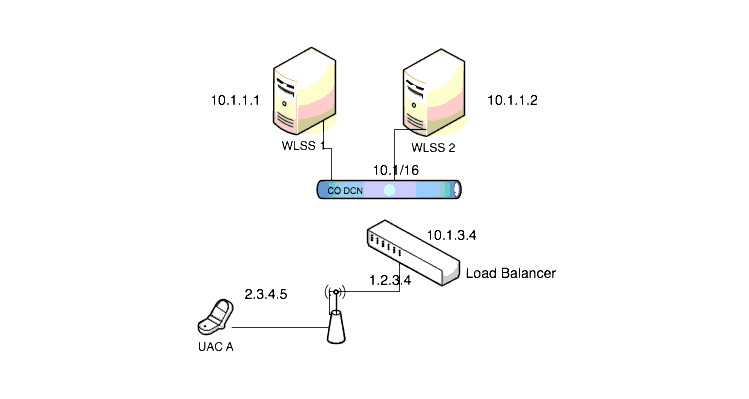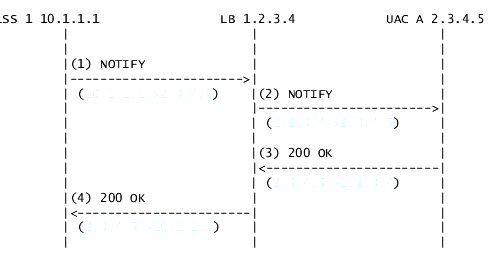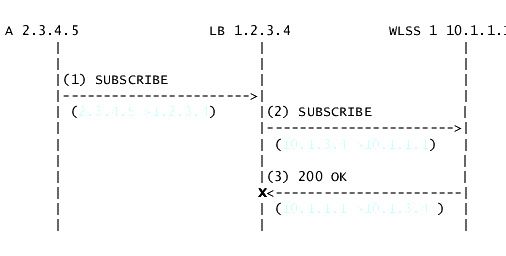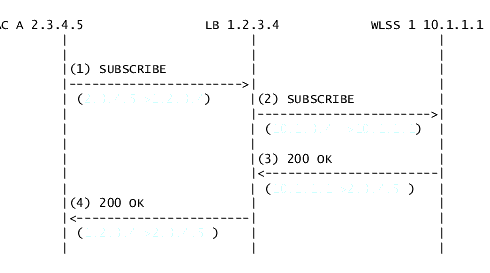







|
The following sections describe a sample network configuration for WebLogic SIP Server using a non-SIP-aware load balancer:
WebLogic SIP Server is compatible with load balancers that are not SIP-aware, meaning that they do not consider existing SIP dialogues when routing requests to servers. This document demonstrates load balancer and WebLogic SIP Server configuration, as well as SIP and Network Address Translation (NAT) interactions in various configurations.
For more information about implementation-dependent issues surrounding NAT see the IETF document, NAT Behavioral Requirements for Unicast UDP.
Figure 3-1 shows the sample network topology described in this section. A WebLogic SIP Server cluster, consisting of engines WLSS 1 and WLSS 2, is configured on private IP network 10.1/16 (an internal 16-bit subnet). The cluster's public IP address is 1.2.3.4, which is the virtual IP address configured on the load balancer.
The User Agent, UAC A, with IP address 2.3.4.5 never sees the internal IP addresses configured for the WebLogic SIP Server cluster. Instead, it sends requests to, and receives responses from 1.2.3.4.
The sections that follow discuss configuring the WebLogic SIP Server cluster and load balancer for this example system.

The WebLogic SIP Server cluster configuration specifies the public address as 1.2.3.4, and the public port as 5060 (see Configuring Load Balancer Addresses on page 1-3) for each engine. The default route on both WebLogic SIP Server engines points to the load balancer's 10.1/16 network interface: 10.1.3.4. The WebLogic SIP Server (servers WLSS 1 and WLSS 2) routing table is shown in Listing 3-1.
$ /sbin/routeKernel IP routing table
Destination Gateway Genmask Flags Metric Ref Use Iface
10.1.0.0 * 255.255.0.0 U 0 0 0 eth0
default 10.1.3.4 0.0.0.0 UG 0 0
The load balancer is configured with a virtual IP address of 1.2.3.4, and two real servers, WLSS 1 and WLSS 2, having addresses 10.1.1.1 and 10.1.1.2, respectively. The load balancer also has an internal IP address of 10.1.3.4 configured on the 10.1/16 network. The UAC address, 2.3.4.5, is reachable from the load balancer by static route configuration on the load balancer. The load balancer routing table is shown in Listing 3-2.
$ /sbin/routeKernel IP routing table
Destination Gateway Genmask Flags Metric Ref Use Iface
10.1.0.0 * 255.255.0.0 U 0 0 0 eth1
1.2.0.0 * 255.255.0.0 U 0 0
Because the SIP protocol specification (RFC 3261) dictates the destination IP address and UDP port numbers that user agents must use when sending requests or responses, the NAT configuration of the load balancer must be done in a way that does not violate RFC 3261 requirements. Two setup options can be used to accomplish this configuration:
The sections that follow describe each approach.
The default UDP NAT behavior for load balancers is to perform destination IP address translation in the public->private network direction, and source IP address translation in the private->public network direction. This means setting up destination address translation in the UAC->WebLogic SIP Server (2.3.4.5->1.2.3.4) direction without source address translation, and source address translation in the WebLogic SIP Server->UAC (10.1/16->2.3.4.5) direction without destination address translation.
Figure 3-2 illustrates the UDP packet flow for a SUBSCRIBE/200OK transaction.

Note that the source and destination IP addresses of the UDP packets are shown in blue. In the UAC->WebLogic SIP Server direction, the load balancer translates the destination IP address but not the source IP address. In the WebLogic SIP Server->UAC direction, the load balancer translates the source IP address but not the destination IP address.
The complete message trace (including IP and UDP headers, as well as the SIP payload) for the sequence from Figure 3-2 is shown in Listing 3-3 below.
No. Time Source Destination Protocol Info
1 1.425250 2.3.4.5 1.2.3.4 SIP Request: SUBSCRIBE sip:subscribe@1.2.3.4:5060
Internet Protocol, Src: 2.3.4.5 (2.3.4.5), Dst: 1.2.3.4 (1.2.3.4)
User Datagram Protocol, Src Port: 9999 (9999), Dst Port: sip (5060)
Session Initiation Protocol
Request-Line: SUBSCRIBE sip:subscribe@1.2.3.4:5060 SIP/2.0
Message Header
Via: SIP/2.0/UDP 2.3.4.5:9999;branch=1
From: sipp <sip:sipp@2.3.4.5>;tag=1
To: sut <sip:subscribe@1.2.3.4:5060>
Call-ID: 1-25923@2.3.4.5
Cseq: 1 SUBSCRIBE
Contact: sip:sipp@2.3.4.5:9999
Max-Forwards: 70
Event: ua-profile
Expires: 10
Content-Length: 0
No. Time Source Destination Protocol Info
2 2.426250 2.3.4.5 10.1.1.1 SIP Request: SUBSCRIBE sip:subscribe@1.2.3.4:5060
Internet Protocol, Src: 2.3.4.5 (2.3.4.5), Dst: 10.1.1.1 (10.1.1.1)
User Datagram Protocol, Src Port: 9999 (9999), Dst Port: sip (5060)
Session Initiation Protocol
Request-Line: SUBSCRIBE sip:subscribe@1.2.3.4:5060 SIP/2.0
Message Header
Via: SIP/2.0/UDP 2.3.4.5:9999;branch=1
From: sipp <sip:sipp@2.3.4.5>;tag=1
To: sut <sip:subscribe@1.2.3.4:5060>
Call-ID: 1-25923@2.3.4.5
Cseq: 1 SUBSCRIBE
Contact: sip:sipp@2.3.4.5:9999
Max-Forwards: 70
Event: ua-profile
Expires: 10
Content-Length: 0
No. Time Source Destination Protocol Info
3 3.430903 10.1.1.1 2.3.4.5 SIP Status: 200 OK
Internet Protocol, Src: 10.1.1.1 (10.1.1.1), Dst: 2.3.4.5 (2.3.4.5)
User Datagram Protocol, Src Port: 42316 (42316), Dst Port: 9999 (9999)
Session Initiation Protocol
Status-Line: SIP/2.0 200 OK
Message Header
To: sut <sip:subscribe@1.2.3.4:5060>;tag=82722c03
Content-Length: 0
Contact: <sip:app-12eomtm5h5f77@1.2.3.4:5060;transport=udp;wlsscid=1ae4479ac6ff71>
CSeq: 1 SUBSCRIBE
Call-ID: 1-25923@2.3.4.5
If WebLogic SIP Server subsequently sends a NOTIFY request to the UAC, the sequence shown in Figure 3-3 takes place:

As in the previous sequence, the IP address translation takes place in the WebLogic SIP Server->UAC direction for the source IP address, and UAC->WebLogic SIP Server direction for the destination IP address.
Note that this setup does not require the load balancer to maintain session state information or to be SIP-aware. The complete message trace from Figure 3-3 is shown in Listing 3-4 below.
No. Time Source Destination Protocol Info
1 5.430952 10.1.1.1 2.3.4.5 SIP Request: NOTIFY sip:sipp@2.3.4.5:9999
Internet Protocol, Src: 10.1.1.1 (10.1.1.1), Dst: 2.3.4.5 (2.3.4.5)
User Datagram Protocol, Src Port: 42316 (42316), Dst Port: 9999 (9999)
Session Initiation Protocol
Request-Line: NOTIFY sip:sipp@2.3.4.5:9999 SIP/2.0
Message Header
To: sipp <sip:sipp@2.3.4.5>;tag=1
Content-Length: 0
Contact: <sip:app-12eomtm5h5f77@1.2.3.4:5060;transport=udp;wlsscid=1ae4479ac6ff71>
CSeq: 1 NOTIFY
Call-ID: 1-25923@2.3.4.5
Via: SIP/2.0/UDP 1.2.3.4:5060;wlsscid=1ae4479ac6ff71;branch=z9hG4bKc5e4c3b4c22be517133ab749adeece4e
From: sut <sip:subscribe@1.2.3.4:5060>;tag=82722c03
Max-Forwards: 70
No. Time Source Destination Protocol Info
2 6.430952 1.2.3.4 2.3.4.5 SIP Request: NOTIFY sip:sipp@2.3.4.5:9999
Internet Protocol, Src: 1.2.3.4 (1.2.3.4), Dst: 2.3.4.5 (2.3.4.5)
User Datagram Protocol, Src Port: 2222 (2222), Dst Port: 9999 (9999)
Session Initiation Protocol
Request-Line: NOTIFY sip:sipp@2.3.4.5:9999 SIP/2.0
Message Header
To: sipp <sip:sipp@2.3.4.5>;tag=1
Content-Length: 0
Contact: <sip:app-12eomtm5h5f77@1.2.3.4:5060;transport=udp;wlsscid=1ae4479ac6ff71>
CSeq: 1 NOTIFY
Call-ID: 1-25923@2.3.4.5
Via: SIP/2.0/UDP 1.2.3.4:5060;wlsscid=1ae4479ac6ff71;branch=z9hG4bKc5e4c3b4c22be517133ab749adeece4e
From: sut <sip:subscribe@1.2.3.4:5060>;tag=82722c03
Max-Forwards: 70
No. Time Source Destination Protocol Info
3 7.431367 2.3.4.5 1.2.3.4 SIP Status: 200 OK
Internet Protocol, Src: 2.3.4.5 (2.3.4.5), Dst: 1.2.3.4 (1.2.3.4)
User Datagram Protocol, Src Port: 9999 (9999), Dst Port: sip (5060)
Session Initiation Protocol
Status-Line: SIP/2.0 200 OK
Message Header
Via: SIP/2.0/UDP 1.2.3.4:5060;wlsscid=1ae4479ac6ff71;branch=z9hG4bKc5e4c3b4c22be517133ab749adeece4e
From: sut <sip:subscribe@1.2.3.4:5060>;tag=82722c03
To: sipp <sip:sipp@2.3.4.5>;tag=1;tag=1
Call-ID: 1-25923@2.3.4.5
CSeq: 1 NOTIFY
Contact: <sip:2.3.4.5:9999;transport=UDP>
| WARNING: | If NAT is performed on both the source (SNAT) and destination IP addresses, the configuration does not work because the load balancer usually relies on a specific destination port number value to be sent in responses to requests. That port number value is dictated by RFC 3261, and must come from the Via header, which presents a conflict with load balancer's NAT requirements. RFC 3261 requires that responses to SIP requests be sent to the IP address used to send the request (unless maddr is present in the Via, as described in maddr-Based Configuration on page 3-12). Consequently, in Figure 3-4 below, Step 3, WebLogic SIP Server sends a 200 OK response to the load balancer internal IP address (10.1.3.4) and port 5060. That response is then dropped. |

The complete message trace from Figure 3-4 is show in Listing 3-5 below.
No. Time Source Destination Protocol Info
1 1.425250 2.3.4.5 1.2.3.4 SIP Request: SUBSCRIBE sip:subscribe@1.2.3.4:5060
Internet Protocol, Src: 2.3.4.5 (2.3.4.5), Dst: 1.2.3.4 (1.2.3.4)
User Datagram Protocol, Src Port: 9999 (9999), Dst Port: sip (5060)
Session Initiation Protocol
Request-Line: SUBSCRIBE sip:subscribe@1.2.3.4:5060 SIP/2.0
Message Header
Via: SIP/2.0/UDP 2.3.4.5:9999;branch=1
From: sipp <sip:sipp@2.3.4.5>;tag=1
To: sut <sip:subscribe@1.2.3.4:5060>
Call-ID: 1-25923@2.3.4.5
Cseq: 1 SUBSCRIBE
Contact: sip:sipp@2.3.4.5:9999
Max-Forwards: 70
Event: ua-profile
Expires: 10
Content-Length: 0
No. Time Source Destination Protocol Info
2 2.426250 10.1.3.4 10.1.1.1 SIP Request: SUBSCRIBE sip:subscribe@1.2.3.4:5060
Internet Protocol, Src: 10.1.3.4 (10.1.3.4), Dst: 10.1.1.1 (10.1.1.1)
User Datagram Protocol, Src Port: 2222 (2222), Dst Port: sip (5060)
Session Initiation Protocol
Request-Line: SUBSCRIBE sip:subscribe@1.2.3.4:5060 SIP/2.0
Message Header
Via: SIP/2.0/UDP 2.3.4.5:9999;branch=1
From: sipp <sip:sipp@2.3.4.5>;tag=1
To: sut <sip:subscribe@1.2.3.4:5060>
Call-ID: 1-25923@2.3.4.5
Cseq: 1 SUBSCRIBE
Contact: sip:sipp@2.3.4.5:9999
Max-Forwards: 70
Event: ua-profile
Expires: 10
Content-Length: 0
No. Time Source Destination Protocol Info
3 3.430903 10.1.1.1 10.1.3.4 SIP Status: 200 OK
Internet Protocol, Src: 10.1.1.1 (10.1.1.1), Dst: 10.1.3.4 (10.1.3.4)
User Datagram Protocol, Src Port: 42316 (42316), Dst Port: 9999 (9999)
Session Initiation Protocol
When the maddr parameter is present in the Via header, the response is sent to the IP address specified in the maddr rather than to the received IP address (even when SNAT is enabled). In the example below, the UAC specifies a maddr set to 2.3.4.5 in the Via header. Consequently the response from the SIP server makes it to the UAC.

The complete message trace from Figure 3-5 is shown in Listing 3-6 below.
No. Time Source Destination Protocol Info
1 1.425250 2.3.4.5 1.2.3.4 SIP Request: SUBSCRIBE sip:subscribe@1.2.3.4:5060
Internet Protocol, Src: 2.3.4.5 (2.3.4.5), Dst: 1.2.3.4 (1.2.3.4)
User Datagram Protocol, Src Port: 9999 (9999), Dst Port: sip (5060)
Session Initiation Protocol
Request-Line: SUBSCRIBE sip:subscribe@1.2.3.4:5060 SIP/2.0
Message Header
Via: SIP/2.0/UDP 2.3.4.5:9999;maddr=2.3.4.5;branch=1
From: sipp <sip:sipp@2.3.4.5>;tag=1
To: sut <sip:subscribe@1.2.3.4:5060>
Call-ID: 1-25923@2.3.4.5
Cseq: 1 SUBSCRIBE
Contact: sip:sipp@2.3.4.5:9999
Max-Forwards: 70
Event: ua-profile
Expires: 10
Content-Length: 0
No. Time Source Destination Protocol Info
2 2.426250 10.1.3.4 10.1.1.1 SIP Request: SUBSCRIBE sip:subscribe@1.2.3.4:5060
Internet Protocol, Src: 10.1.3.4 (10.1.3.4), Dst: 10.1.1.1 (10.1.1.1)
User Datagram Protocol, Src Port: 2222 (2222), Dst Port: sip (5060)
Session Initiation Protocol
Request-Line: SUBSCRIBE sip:subscribe@1.2.3.4:5060 SIP/2.0
Message Header
Via: SIP/2.0/UDP 2.3.4.5:9999;maddr=2.3.4.5;branch=1
From: sipp <sip:sipp@2.3.4.5>;tag=1
To: sut <sip:subscribe@1.2.3.4:5060>
Call-ID: 1-25923@2.3.4.5
Cseq: 1 SUBSCRIBE
Contact: sip:sipp@2.3.4.5:9999
Max-Forwards: 70
Event: ua-profile
Expires: 10
Content-Length: 0
No. Time Source Destination Protocol Info
3 3.430903 10.1.1.1 2.3.4.5 SIP Status: 200 OK
Internet Protocol, Src: 10.1.1.1 (10.1.1.1), Dst: 2.3.4.5 (2.3.4.5)
User Datagram Protocol, Src Port: 42316 (42316), Dst Port: 9999 (9999)
Session Initiation Protocol
Status-Line: SIP/2.0 200 OK
Message Header
To: sut <sip:subscribe@1.2.3.4:5060>;tag=82722c03
Content-Length: 0
Contact: <sip:app-12eomtm5h5f77@1.2.3.4:5060;transport=udp;wlsscid=1ae4479ac6ff71>


|